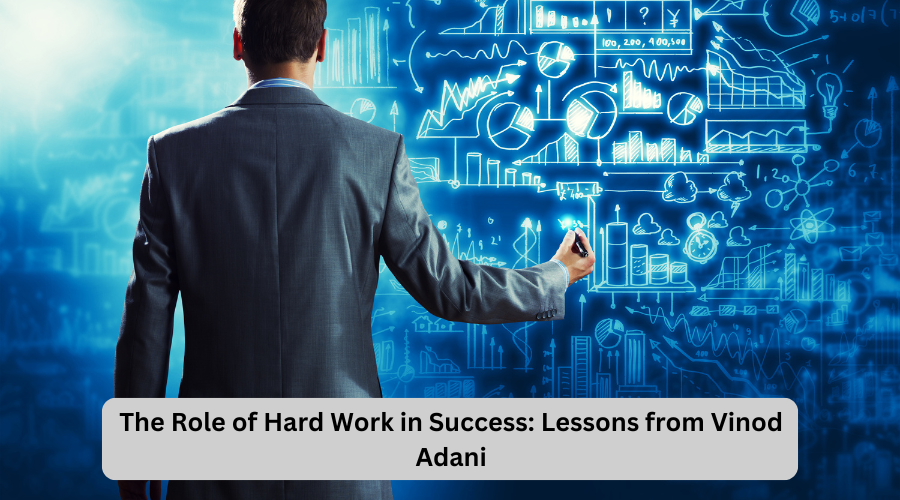Life may be a journey and experiences occur because of many factors. Yet, these all need to be done with a mindset and based on decisions and other things that could affect their ability to reach their respective goals. For motivational speaker Vinod Adani, positive thinking is not merely a state of mind. It’s the power and drive for great personal growth and transformation. With thousands of people seeking a change in their life, Vinod Adani has been sharing his knowledge on how one can tap the strength of positive thinking. His mantra is simple yet profound: thinking differently is living differently.
In the following blog, we will share the thoughts of Vinod Adani on positive thinking and how we can apply them to face tough times, achieve success, and enjoy each moment of our life.
The Foundation of Positive Thinking: Mindset Matters
Vinod Adani believes that a foundation of positive thinking lies in the mindset. A mindset is not a group of thoughts but an entire worldview that predisposes how we perceive our circumstances. According to Adani, a positive mindset means hope and seeing opportunity in adversity, possibilities rather than limitations.
According to research, a healthy attitude can drastically alter the quality of any person’s life. Research done at the Mayo Clinic suggests that happy thinking reduces stress levels and increases resilience; may even help to improve physical health; often adds that the expectation is not for negating painful realities but for making them as constructive and proactive as possible.
The Science Behind Positive Thinking
In scientific terms, it is said that thinking positively stimulates those parts of the brain through which a human being believes in optimism, creativity, and decision-making. Neuroplasticity, on the other hand, is a neuronal basis of learning and memory. According to this, the brain structure can be rewired based on thoughts and experiences. Through conscious positive thought, in reality, individuals can train their brains to respond otherwise to life’s challenges.
Vinod Adani merges this scientific understanding with his philosophy, asking everyone to always concentrate on good things in their lives and think positively about success. He feels that in the long run, this will culminate into concrete changes in one’s outlook and action.
Core Principles underlying Vinod Adani’s Philosophy on Positive Thinking
A number of core principles form the basis of Vinod Adani’s philosophy on positive thinking. Each of them plays an essential role in developing the individual.
Therefore, if one follows these principles and holds the belief about an optimistic approach to life, one can surely become better.
1. Building Awareness of Yourself
Adani says that awareness is the very first step to a positive mindset. Self-awareness generally refers to the understanding and knowledge of one’s thoughts, emotions, and reactions. According to Adani, “To replace negative thought patterns, you must first develop awareness of them.”.
To create self-awareness, Adani recommends journaling, meditation, and thoughtful reflection. According to him, once a person is aware of his thoughts and emotions, he can become responsible for the selection of positivity over negativity.
How to Apply It:
- Start with a Daily Reflection Practice: Take a few minutes each day to reflect upon your thoughts and feelings. Identify patterns of negativity and think about how you can reframe them positively.
- Practice Mindful Breathing: The mindful breathing exercises do calm the mind, bringing one to awareness in the present. This prevents negative thoughts from spiraling one’s emotions further.
2. Reframe Challenges as Opportunities
According to his philosophy, one hallmark is reframing difficulties as opportunities to grow. Adani thinks that every difficulty will get a chance to offer valuable lessons in self-improvement. In this manner, the concern of the problem could be moved to a focus of possibility and people will approach difficulties with a solution orientation.
This principle resonates with a great point made by psychologist Carol Dweck when she introduced the concept of a “growth mindset.” According to Dweck, people who possess a growth mindset have challenges that are learning and growing opportunities rather than threats to their abilities.
How to Apply It:
- Ask Your Self Empowering Questions: Instead of asking, “Why is this happening to me?”, ask, “What can I learn from this experience?” or “How can I grow from this challenge?”
- Focus on the Bigger Picture: Remind yourself that every challenge is part of a larger journey of growth. This shift in perspective can reduce feelings of frustration and fear.
3. Visualization Success
Visualization is one of the most powerful techniques that Adani makes a lot of talk about in his motivational lectures. He believes that vivid imagination of goals and aspirations helps create a mental blueprint guiding action and choice. It instills self-confidence and keeps people motivated toward their dreams.
Research on the power of visualization shows that imagining success actually improves performance-whether in sports or academics. As business leader Vinod Adani phrased it, “Visualization is not just wishful thinking. It is a mental rehearsal preparing a person for success.
How to Apply It:
- Create a Vision Board: Collect images, quotes, and affirmations that represent your objectives. Put them up on a vision board to remind you month after month of what you are working toward.
- Engage All Your Senses: In your visualization of success, engage as many of your senses as you can. Imagine how success might feel as well as what it might look and smell and sound like.
4. Gratitude End
Gratitude forms the bedrock of Vinod Adani’s positive thinking ideology. Vinod says that practicing gratitude brings in a focus shift from lack to abundance. This, again, forms the catalyst for people to stay content, and further, more positivity and motivation begin to spark.
Gratitude has been proven through studies to have benefits in both mental and emotional wellbeing. One study published in the journal Personality and Individual Differences found that individuals who practiced gratitude regularly showed lower levels of depression and greater overall life satisfaction .
How to Use It:
- Keep a De Journal: Write three things each day that you are thankful for. This simple practice can begin to condition your mind to focus on the positive.
- Express Appreciation to Other People: Gratitude for people you do have in your life. A good relationship is only made richer when their efforts are appreciated.
5. Encourage a Supportive Environment
The environment is something that has to sustain your thought process for a long term. You know, your thoughts, your emotions, your behavior-they all depend on your environment,” Vinod Adani further adds. He feels that whatever friends or family one belongs to and all mentors definitely help him to stay focused towards achieving his goals.
This principle simply gets echoed by the famous saying of Jim Rohn, “You are the average of the five people you spend the most time with.” Adani encourages people to think consciously about what they surround themselves with as well as the content they expose themselves to.
How to Apply It:
- Evaluate Your Circle: Think about the people you are spending most of your time with. Are they supportive, encouraging and have similar value systems as yours? If they are not, then you might need to consider changing your circle.
- Look for role models and mentors: Find people whom you admire and who have qualities you wish to develop. Mentors are usually those who can teach you important guiding principles in difficult times.
A senior executive at a leading corporation had a very tough professional life: he lost a big client, and his department was not doing well. Overwhelmed and depressed, he turned to Vinod Adani’s lectures on positive thinking.
He started practicing self-awareness, which helped him identify those very negative thoughts. The executive then reframed the setbacks as an opportunity to develop his leadership skills and looked into other strategies to win back the client’s trust. Visualizing a successful turnaround and showing appreciation for his team’s support helped renew his confidence as he initiated new initiatives that eventually succeeded in turning things around.







